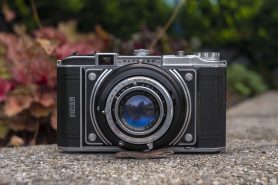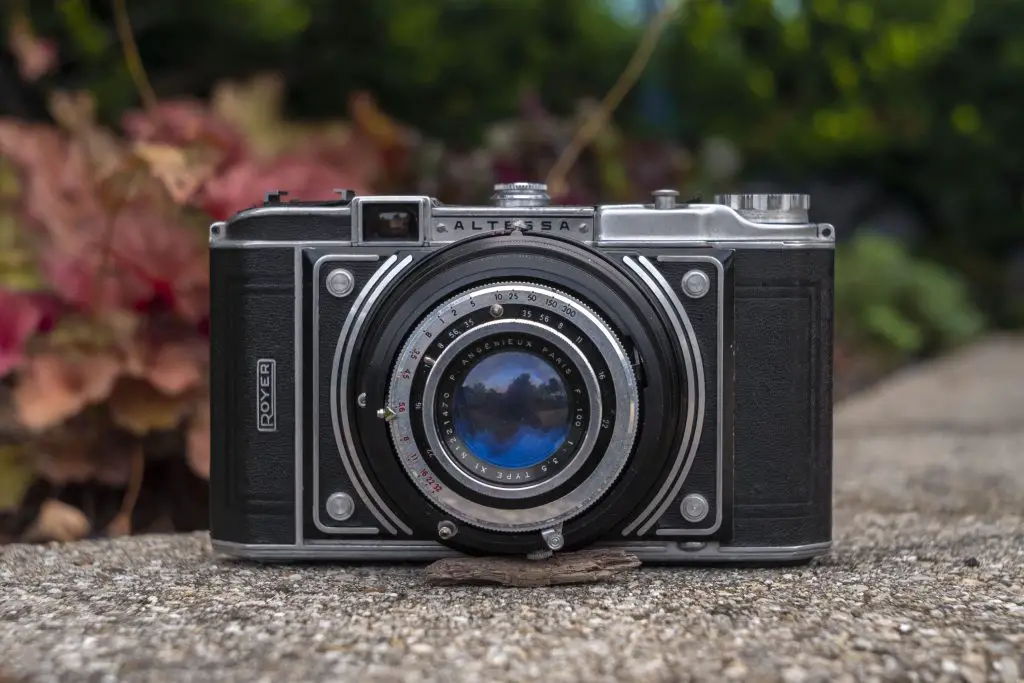 This is a Royer Altessa Type IV, a very unique non-folding roll film camera produced by Société Industrielle de Technique Optique (SITO) between the years 1952 and 1954. The Altessa has an interchangeable bayonet lens mount and shoots both 6cm x 9cm and with a baffle, 6cm x 6cm images on 120 or 620 format roll film. Although resembling a folding camera, the Altessa does not have any sort of bellows, but rather the front lens and shutter extend and retract on a collapsible metal tube. The camera uses a standard leaf shutter for making the exposure, but has a second cloth shutter in the film compartment to protect film in the camera when removing the lens from the body. This Type IV version was the top of the line in the Altessa series, featuring a 100mm f/3.5 P. Angénieux Type X1 lens.
This is a Royer Altessa Type IV, a very unique non-folding roll film camera produced by Société Industrielle de Technique Optique (SITO) between the years 1952 and 1954. The Altessa has an interchangeable bayonet lens mount and shoots both 6cm x 9cm and with a baffle, 6cm x 6cm images on 120 or 620 format roll film. Although resembling a folding camera, the Altessa does not have any sort of bellows, but rather the front lens and shutter extend and retract on a collapsible metal tube. The camera uses a standard leaf shutter for making the exposure, but has a second cloth shutter in the film compartment to protect film in the camera when removing the lens from the body. This Type IV version was the top of the line in the Altessa series, featuring a 100mm f/3.5 P. Angénieux Type X1 lens.
Film Type: 120 or 620 Roll Film (eight 6cm x 9cm or twelve 6cm x 6cm exposures per roll)
Lens: 100mm f/3.5 P. Angénieux Type X1 coated 4-elements in 3-groups
Lens Mount: Royer Altessa Bayonet
Focus: 3.5 feet to Infinity
Viewfinder: Scale Focus Optical Viewfinder
Shutter: Between the Lens Leaf
Speeds: B, 1 – 1/300 seconds
Exposure Meter: None
Battery: None
Flash Mount: None
Other Features: Self-Timer
Weight: 712 grams
Manual: None
History
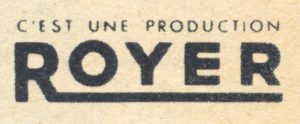 The name Royer does not refer to a company, rather a brand of cameras produced in France by Société Industrielle de Technique Optique, or SITO for short from about 1948 until the mid 1960s. The company was founded by an optical mechanic named René Royer who had previously worked for the French cinematography company, Lumière during the war.
The name Royer does not refer to a company, rather a brand of cameras produced in France by Société Industrielle de Technique Optique, or SITO for short from about 1948 until the mid 1960s. The company was founded by an optical mechanic named René Royer who had previously worked for the French cinematography company, Lumière during the war.
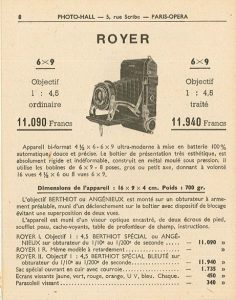
After World War II, the French government instituted some protectionist measures to help speed up the recovery of French industry by forbidding foreign imports in numerous sectors of the economy, including photographic equipment. As a result, a number of small photographic and optical companies were created to fill a void of imported photographic goods that could no longer be obtained from Germany and other countries.
Sensing an opportunity to branch out on his own, Royer left Lumière to form his own company and start making cameras under his own name. Royer had experience with folding medium format cameras from his time at Lumière so those were some of the first models produced starting in 1948.
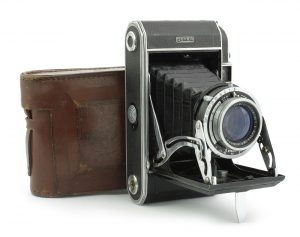
The first cameras, simply called the Royer I and II were inexpensive 6×9 folders that came with either Berthiot or Angénieux lenses in a simple leaf shutter.
In the years that would follow, a large number of variations of that original Royer camera would be created, with incremental changes including better lenses and shutters, some with flash synchronization and others with self timers. The basic body of Royer 6×9 folding cameras would be retained for a while, even on the company’s higher end models.

In 1950, a top of the line model called the Royer Teleroy was created with the company’s first ever rangefinder. The prefix “tele-” in the camera’s name is short for telemeter, which is another word for rangefinder, hence the ‘tele-Roy’ or rangefinder Royer.
Two years later, another take on the Royer design called the Altessa made it’s debut. Unlike pretty much every other 6×9 camera made, either by Royer or anyone else, the Altessa had an interchangeable lens mount. In order to accomplish this feat, a number of changes needed to be made.
First, the Altessa did not fold. Instead of collapsible bellows, the lens was mounted to a rigid tube that would extend the lens and shutter to the correct distance away from the film plane to cover the 6×9 image. This was likely done to help support the additional weight and stress of mounting and dismounting lenses.
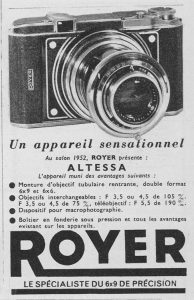
The second change was the additional of a cloth focal plane shutter that acted as a dark slide for the film compartment, which was a necessity of the shutter being part of the interchangeable lens mount. With cameras like the Koni-Omega Rapid or Hasselblad 500 C in which the lens and shutter are one unit, removing the unit allows light to pour into the body of the camera. Without something there to protect the film from being exposed, changing lenses with film in the camera would have been impossible.
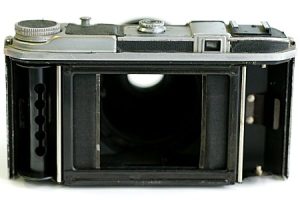
As a added bonus, the cloth curtains for the dark slide, could also be used in a “half” position, allowing for 6cm x 6cm exposures to be made. Unlike other 6×9 cameras that allow for different aspect ratios which use removable baffles, the change from 6×9 to 6×6 could be made mid roll, without ever having to open up the camera.
Three different versions of the Altessa were planned, the Type I, II, and IV, the model being reviewed here is the top of the line Type IV. The entry level model, the Type I lacked the cloth curtains which allowed for mid roll lens changes. A metal 6×6 baffle was included with the camera to still allow for smaller exposures, but could not be changed with film in the camera. The standard lens on the Type I was a 105mm f/4.5 triplet made either by Angénieux or Berthiot. The Type II included the cloth curtains, but still came with one of the two simpler triplet lenses. Finally, the type IV upgraded the lens to a Tessar type 100mm f/3.5 lens either by Angénieux or Berthiot.
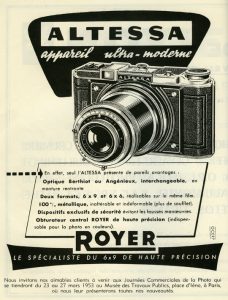
During it’s development, a variety of accessories including lens extension tubes for macro work, a ground glass focusing back, and a universal finder were planned. Additional lenses were also going to be offered such as:
- 75mm f/3.5 or f/4.5 Normal Lens for 6×6 format
- 80mm f/6.8 Berthiot Wide Angle
- 190mm f/5.5 Berthiot Telephoto
Unfortunately, none of these lenses or any of the accessories were ever built as the camera sold too poorly to justify their existence. Whether or not prototypes of these lenses or accessories were made is unknown, but my guess is that they probably were since they were mentioned in the advertisements for the camera.
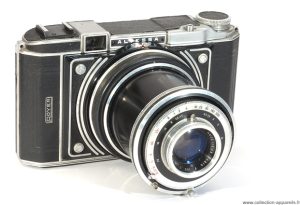
A number of challenges led to the poor sales of the Altessa. Tough postwar economic sanctions on German made products meant that it was almost impossible to get cameras and other photographic gear imported into France, so much of France’s photographic industry catered only to the domestic market. There was little to no demand for exported French cameras, so the potential pool of worldwide customers never existed for cameras like the Altessa.
Second, the design of the bayonet lens mount was flawed. It was very fragile and prone to damage and light leaks. Changing lenses on the Altessa was not as simple as that of 35mm cameras or other solid bodied medium format cameras. Finally, the demand for a 6×9 rangefinderless camera with interchangeable lenses simply didn’t exist. Sometimes a market segment fails because there is no demand for it, and that is what appeared to happen with the Altessa.
Despite not selling well, information online suggests the camera was offered until 1954. Whether it was in production this long, or if that’s just how long it took to sell new old stock items is not clear. There is also no information about the price of the camera. On his page for the Altessa IV, Sylvain Halgand says the price was reasonable, suggesting that a high cost did not contribute to the camera’s failure.
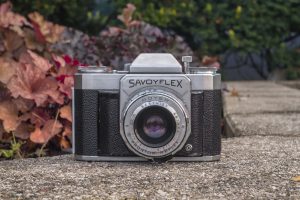
It is not clear when this happened, but by the mid 1950s, the name SITO would no longer appear on the company’s advertisements, instead all cameras being referred to as being made by Royer. It is not clear whether or not SITO officially changed it’s name to Royer to identify with it’s most popular product, or if this was just a rebranding. Whatever the case, Royer would continue to produce other cameras, including a large number of 35mm cameras starting with the simple Savoy scale focus camera, and peaking with the auto exposure Royer Savoyflex Automatic SLR.
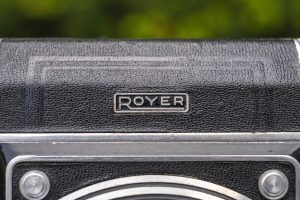
Royer would continue to produce cameras into the 1960s, but a shift in trade options for France allowed more and more German and Japanese cameras to enter the market place, and despite some innovative models, the allure of French marques caused the entire industry to disappear.
Today, cameras like the Altessa are difficult to rate, as their rarity also leads to unfamiliarity. I had never heard of this camera until the moment I saw this example, and I suspect many collectors have the same experience. But for those who have the option to pick one up, to have a model like this with such an uncommon set of features, made by a company known for decent cameras, is an easy recommendation. Just be prepared to open your wallets, especially if you are in the US, as prices on these can get ridiculous quick!
My Thoughts
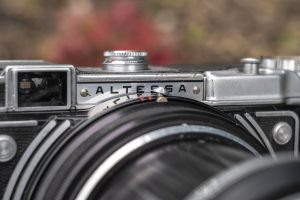
In the midst of the COVID-19 lockdown in the Summer 2020, I found myself like a lot of people with a lot more free time on my hands. “Idle hands are the devil’s workshop” they say, but in my case, idle hands got me bidding on a 10 camera auction from KEH that had a bunch of European cameras that I had never heard of. In February 2021, I reviewed the Royer Teleroy, a very nice folding 6×9 camera with a unique coupled rangefinder. I shot that camera and got some great results from it, but sadly, this Altessa wasn’t in as good of shape. I had wanted to put some film through it, but thought that even if I were to finish a roll, the results wouldn’t differ much from the Teleroy, so if you want to see some sample images, I recommend checking out that review.
In the world of unique cameras, there are a whole bunch for collectors to choose from. In the early to mid 20th century, what was considered a modern rangefinder or SLR or what features photographers really wanted was still very much in the air, so cameras with strange combinations of features were pretty common. To my knowledge, the Royer Altessa was the only collapsible lens 6×9 camera with a bayonet lens mount.
Like the Teleroy, the Altessa’s body is made of solid aluminum, and is very sturdy. The body covering is still in tact, and all of the various metal bits are nice and shiny with only a slight hint of oxidation. The Altessa weighs less than the Teleroy likely due to the lack of the additional glass and metal for the rangefinder, no folding bed, and the lightweight hollow tubes that although made of some kind of metal, feel very thin.
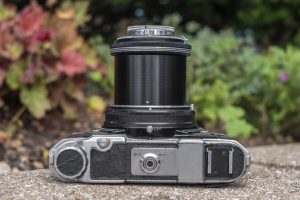
The Altessa’s top plate has a lot going on, due to controls not normally found on most 6×9 cameras. Starting on the left is the film advance knob. It is hard to see in the image to the left, but the word “WIND” and a clockwise arrow is embossed into the leather indicating the direction of travel.
Above and to the right of this knob is a small indicator for the camera’s double exposure prevention feature. When the indicator is white, the shutter release button to it’s right is locked, preventing you from trying to fire the shutter, but when it turns red, the shutter release is unlocked and you may press it. Other than the shutter release, the Altessa lacks any coupling between the lens and top plate, so you must still manually cock the shutter before pressing the shutter release. Pressing the shutter release without cocking the shutter, will re-engage the double exposure prevention, requiring you to rotate the film advance to unlock it, wasting film.

In the center, next to the viewfinder is the control dial for the cloth curtains inside the film compartment. There are three positions, 6×9, 6×6, and “O”. With the dial in the 6×9 position, the curtains are completely open, letting all the light through to the film plane. In the 6×6 position, the curtains are partially shut, allowing for square exposures to be made. The “O” position closes the curtains entirely, so that you may swap lenses with film in the camera. Although the “O” position looks to be next the 6×9 position on the dial, you cannot turn between these two settings, and must go the entire opposite direction. An interlock between this dial and the bayonet lens mount is engaged in either the 6×6 or 6×9 positions, preventing you from removing the lens with the curtains open.
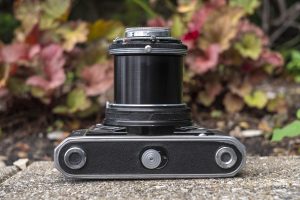
The bottom of the camera has two small feet on opposite ends with one containing the 3/8″ tripod socket. If you wanted to use this camera with a modern tripod, you’d need to get a 1/4″ adapter to make it fit. In the center is the circular lock for the film back. With the letter “F” visible, the back is locked. Move the circular slider so that it entirely covers the letter “F” and you may slide the back of the camera off.
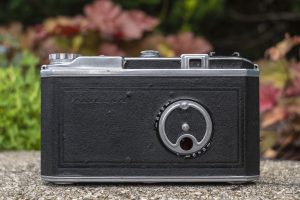
Around back, a large circular door has an opening that can be used for both 6×9 and 6×6 images. Depending on which you are shooting, you rotate the entire dial, positioning the opening in the center for 6×6 and near the edge for 6×9. Also, in the upper left corner of the back is an embossed logo that says “Altessa”. Above the door, near the upper right corner is the eyepiece opening for the viewfinder.
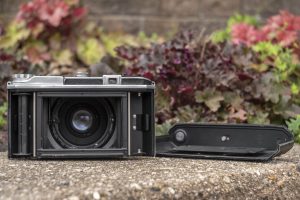
With the curtains open, the film compartment looks pretty ordinary. Other than seeing the inside of the bayonet lens mount and the edges of the cloth curtains, this could be any 6×9 folding camera. The Royer Altessa supports both 620 and 120 films, and transports from right to left. Springs on the bottom flange hold the spools in place when film is in the camera. The inside of the film door has a large and dimpled film pressure plate with two holes for the exposure counter holes.
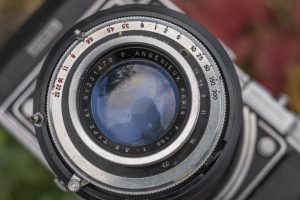
Up front, the shutter on the 100mm f/3.5 P. Angénieux Type X1 lens has speeds from 1 to 1/300 plus Bulb in black selected by a dial around the rim, and apertures from f/3.5 to f/32 in red selected by a small pin on the left side of the shutter. The shutter cocking lever is near the very bottom of the shutter and a flash sync port near the bottom left corner.
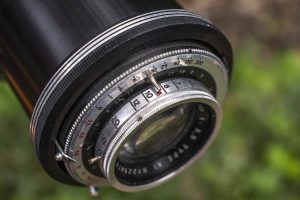
The lens uses a front unit focus in which the entire front grouping is rotated. Focus distances from 2 meters to infinity are chosen by rotating the lens nearly 360 degrees. A depth of field scale is printed on the front face of the shutter, and a red dot exists between 8 and 10 meters to indicate a zone focus mark which can be used for most outdoor shooting situations.
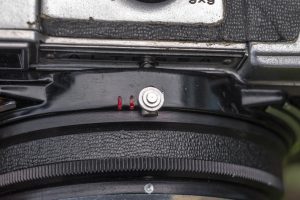
Changing lenses on the Altessa is an inelegant process. An interlock from between the knob controlling the cloth curtains and the lens mount prevents you from removing the lens with the curtains open. In the image to the right, you can see this lock and spring behind the lens mount, just in front of the Altessa logo plate. In front of the lens mount itself, is a chrome slider that rests in a notch on the actual lens. To remove the lens, you must simultaneously push back on this slider while also pressing a button near the 9 o’clock position of the shutter while turning the lens counterclockwise. Even with the curtains closed in “O” mode, the interlock is still there, you just have to push it out of the way with this slider. Two red hash marks are used to line up the lens when reattaching it to the body.
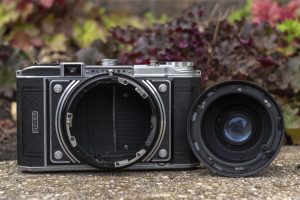
With the interlock disengaged, and the chrome slider pushed into the body, press a release pin on the left side of the lens and give the entire lens tube a twist. The lens, shutter, and tube come off all in one piece. I’ve never seen any other lenses for the Altessa, but I have to imagine that had the camera been successful and a variety of lenses with different focal lengths were produced, they probably would have been ungainly to carry around. Furthermore, since the lens, shutter, and lens tube are all one piece, replacing one means you replace them all, so buying other lenses probably carried a steep price tag, as every lens came with it’s own shutter.
Adding to the challenges of swapping lenses on the Altessa, on this example, the bayonet was extremely stiff and difficult to move. The actual bayonets are made of thin steel and likely would not have held up to repeated use. While this certainly can be a result of age, that evidence exists the lens mount was problematic even when the camera was new, does not give me hope that it would be better on another example.
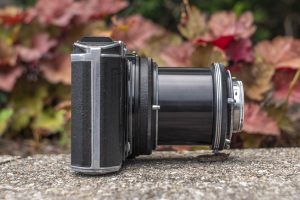
From the camera’s left side, you can see the lens lock button at the 9 o’clock position around the shutter, mentioned in the previous section. From this side, with the lens extended, you can get a feel for how long the camera is. In reality, this is the same distance the lens and shutter would be away from the body had this been a folding camera, but it somehow looks more egregious with the lens tube.
The sides of the actual body have nothing to see, not even strap lugs, suggesting the only way to carry this camera for extended shooting sessions would have been to use whatever strap came on the original ever ready case.
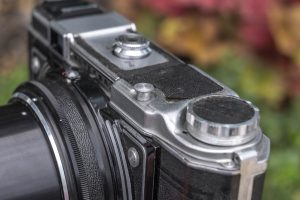
The optical viewfinder on the Altessa is a straight through Galilean finder. Small notches above and below the rectangular frame are there to suggest how to frame square 6×6 images when shooting the camera in that mode. No other information is available through the viewfinder.
Overall, the Royer Altessa is a very neat camera. There simply was never another camera like it, and although no other lenses or accessories were ever produced, I have to imagine that one of these with a wide angle or telephoto lens could have been a pretty neat camera to have. Perhaps had the Altessa been more successful, a later model with a rangefinder might have been made, further adding to the camera’s allure.
Of course, none of that happened and the Altessa remains a one-off curiosity. If you ever have a chance to handle or pick up one of these cameras yourself, go for it. There’s a good chance the cloth curtains will be rotted out and that the lens will be pretty difficult to get off, but if you get a chance to shoot one, please let me know in the comments below!
Related Posts You Might Enjoy
External Links
http://glangl1.free.fr/Photo2/Photo_R_1101.html (in French)
http://35mm-compact.com/forum/viewtopic.php?f=21&t=42134 (in French)
http://www.lallement.com/pictures/Altessa/Altessa.html
https://www.collection-appareils.fr/x/html/appareil-11790-Royer_Altessa%20IV.html
http://www.collection-appareils.fr/x/html/camera-13122-Royer.html


